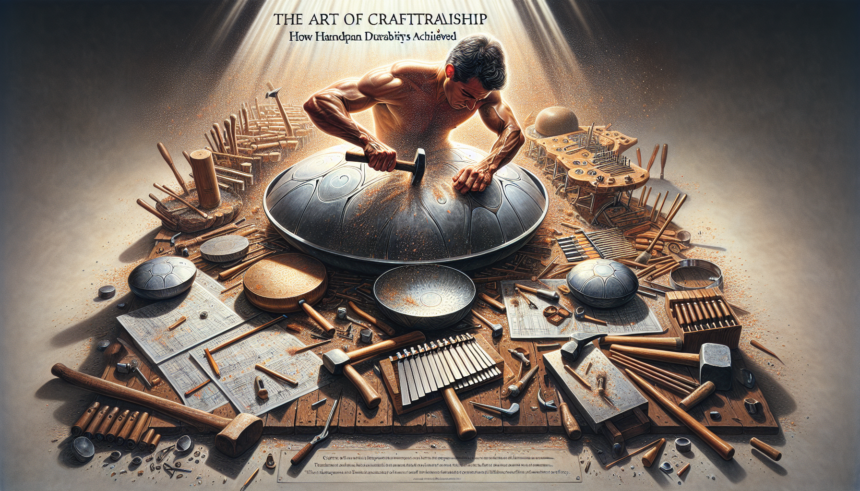Handpans are a relatively recent addition to the world of musical instruments, having been invented in the early 21st century. Known for their ethereal sound and visually appealing form, handpans have found a strong following among musicians, both amateur and professional. Despite their delicate sound, handpans must be constructed with remarkable durability to withstand the rigors of playing and environmental conditions. This article delves into the art of craftsmanship that goes into making handpans and how their durability is achieved.
The Genesis of Handpans
Handpans originated from the Hang, created by Swiss couple Felix Rohner and Sabina Schärer in 2000. The name “Hang” comes from the Bernese German word for “hand,” emphasizing the manual playing style of the instrument. Designed to be played using the hands instead of mallets, the Hang set the foundation for modern handpans. Over time, numerous artisans worldwide have contributed to the evolution and diversification of handpan designs and manufacturing techniques.
Materials Matter
The durability of a handpan begins with the choice of materials. Most handpans are made from steel, specifically nitrided or stainless steel. The nitriding process involves infusing the steel with nitrogen to create a hard, resistant surface layer, enhancing the instrument’s resistance to rust, scratches, and dents. Stainless steel, on the other hand, is naturally resistant to corrosion and offers a unique tonal quality. The selection of high-grade steel is paramount to producing a handpan that can withstand physical and environmental stressors.
The Precision of Shaping
Crafting a handpan involves precise shaping processes to ensure both musical quality and structural integrity. The initial shaping is done through metal-spinning or hydroforming techniques. Metal-spinning involves rotating a metal disc and using tools to shape it into the desired dome form, while hydroforming uses high-pressure fluids to mold the metal. Each method requires meticulous control to maintain uniform thickness and curvature, which are crucial for the instrument’s tonal quality and durability.
The Tuning Process
Once the shell of the handpan is shaped, the next critical step is tuning. This involves hammering specific areas to create notes. Tuners must have a deep understanding of acoustics and metallurgy to achieve the desired sound while ensuring the material’s integrity is not compromised. The hammering process introduces stress within the metal, which needs to be balanced to prevent cracks and other stress-related defects. Master tuners often spend years honing their skills to perfect this delicate balance.
The Role of Heat Treatment
Heat treatment plays a vital role in enhancing the durability of handpans. After the initial shaping and tuning, the instrument undergoes a controlled heating and cooling process. This treatment strengthens the steel by altering its crystalline structure, making it more resilient to impacts and environmental factors. The exact temperatures and durations used during heat treatment are closely guarded secrets among handpan artisans, contributing to the uniqueness of each maker’s instruments.
Assembly and Finishing Touches
The final stages of handpan crafting involve assembling the two halves of the instrument and adding the finishing touches. The halves are carefully aligned and joined, often using adhesive or welding, ensuring a solid bond without compromising the instrument’s resonance. Surface finishing techniques, such as polishing and applying protective coatings, further enhance the durability and aesthetic appeal of the handpan. These coatings often provide additional resistance to corrosion and scratches, preserving the instrument’s longevity.
Testing and Quality Control
Rigorous testing and quality control are essential to ensuring the durability of handpans. Artisans perform extensive sound tests to ensure each note meets the desired pitch and harmonic standards. Physical inspections are also conducted to check for any defects or inconsistencies in the material and construction. Many makers go through multiple iterations of tuning and adjustments before a handpan is deemed ready for use. This meticulous attention to detail ensures that every handpan that leaves the workshop is of the highest quality.
Conclusion
The art of crafting durable handpans is a complex and intricate process that combines advanced materials, precise shaping, expert tuning, and meticulous finishing techniques. Each handpan is a testament to the skill and dedication of its maker, designed to produce beautiful music while withstanding the demands of avid playing and varying environmental conditions. As handpans continue to grow in popularity, the fusion of tradition and innovation in their craftsmanship will ensure that these instruments remain resilient and enduring for generations to come.
Frequently Asked Questions (FAQs)
1. What is the difference between nitrided and stainless steel handpans?
Nitrided steel handpans undergo a nitrogen treatment that hardens the surface, making them more resistant to rust and physical damage. Stainless steel handpans, however, are naturally resistant to corrosion and offer a different, often brighter tonal quality. The choice between the two depends on the desired sound and durability characteristics.
2. How should I care for my handpan to ensure its durability?
To care for your handpan, store it in a dry, temperature-controlled environment, clean it regularly with a soft cloth, and apply a protective oil or wax coating recommended by the maker. Avoid exposing the handpan to extreme temperatures, direct sunlight, or moisture.
3. Can handpans get out of tune over time?
Yes, handpans can gradually lose their tuning due to frequent playing, environmental changes, or impacts. Regular playing, especially with excessive force, can affect the metal’s stability. Periodic retuning by a professional handpan tuner can help maintain its musical quality.
4. How long does it take to make a handpan?
The time required to make a handpan varies depending on the maker and specific design considerations. It usually takes several weeks to months to complete a single handpan, taking into account shaping, tuning, heat treatment, assembly, and quality control processes.
5. Why are handpans so expensive?
Handpans are expensive due to the specialized craftsmanship and materials involved in their creation. The process requires significant skill, time, and precision. Additionally, the uniqueness of each handpan, coupled with the limited number of skilled artisans, contributes to the high cost.





